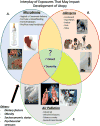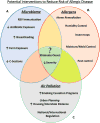Environmental determinants of allergy and asthma in early life
- PMID: 28673399
- PMCID: PMC5675123
- DOI: 10.1016/j.jaci.2017.05.010
Environmental determinants of allergy and asthma in early life
Abstract
Allergic disease prevalence has increased significantly in recent decades. Primary prevention efforts are being guided by study of the exposome (or collective environmental exposures beginning during the prenatal period) to identify modifiable factors that affect allergic disease risk. In this review we explore the evidence supporting a relationship between key components of the external exposome in the prenatal and early-life periods and their effect on atopy development focused on microbial, allergen, and air pollution exposures. The abundance and diversity of microbial exposures during the first months and years of life have been linked with risk of allergic sensitization and disease. Indoor environmental allergen exposure during early life can also affect disease development, depending on the allergen type, dose, and timing of exposure. Recent evidence supports the role of ambient air pollution in allergic disease inception. The lack of clarity in the literature surrounding the relationship between environment and atopy reflects the complex interplay between cumulative environmental factors and genetic susceptibility, such that no one factor dictates disease development in all subjects. Understanding the effect of the summation of environmental exposures throughout a child's development is needed to identify cost-effective interventions that reduce atopy risk in children.
Keywords: Environment; air pollution; allergen; allergy; asthma; endotoxin; exposure; infection; microbiome; tobacco smoke.
Copyright © 2017 American Academy of Allergy, Asthma & Immunology. Published by Elsevier Inc. All rights reserved.
Conflict of interest statement
Figures


References
-
- Wild CP. Complementing the genome with an “exposome”: the outstanding challenge of environmental exposure measurement in molecular epidemiology. Cancer Epidemiol Biomarkers Prev. 2005;14:1847–50. - PubMed
-
- Fishbein AB, Fuleihan RL. The hygiene hypothesis revisited: does exposure to infectious agents protect us from allergy? Curr Opin Pediatr. 2012;24:98–102. - PubMed
-
- Jimenez E, Fernandez L, Marin ML, Martin R, Odriozola JM, Nueno-Palop C, et al. Isolation of commensal bacteria from umbilical cord blood of healthy neonates born by cesarean section. Curr Microbiol. 2005;51:270–4. - PubMed
-
- Jimenez E, Marin ML, Martin R, Odriozola JM, Olivares M, Xaus J, et al. Is meconium from healthy newborns actually sterile? Res Microbiol. 2008;159:187–93. - PubMed
-
- Rautava S, Collado MC, Salminen S, Isolauri E. Probiotics modulate host-microbe interaction in the placenta and fetal gut: a randomized, double-blind, placebo-controlled trial. Neonatology. 2012;102:178–84. - PubMed
Publication types
MeSH terms
Substances
Grants and funding
LinkOut - more resources
Full Text Sources
Other Literature Sources
Medical

